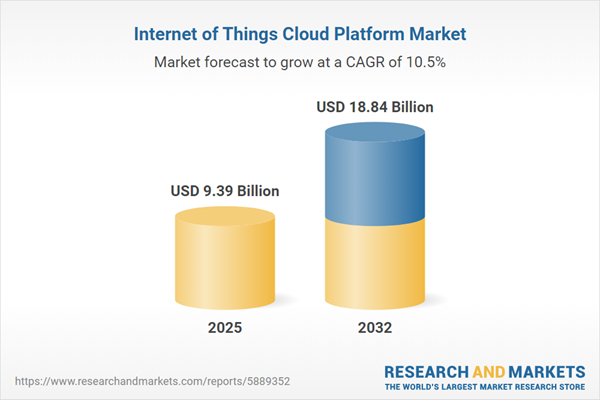Speak directly to the analyst to clarify any post sales queries you may have.
The Internet of Things Cloud Platform Market is rapidly evolving as enterprises seek to optimize infrastructure, reduce complexity, and gain real-time business insights. Industry leaders are leveraging advanced IoT cloud solutions to unlock operational efficiencies, enhance user experiences, and accelerate digital transformation.
Market Snapshot: Internet of Things Cloud Platform Market Growth
The Internet of Things Cloud Platform Market grew from USD 8.49 billion in 2024 to USD 9.39 billion in 2025. It is expected to continue expanding at a CAGR of 10.47%, reaching USD 18.84 billion by 2032. This robust trajectory underscores strong enterprise demand for scalable data aggregation, real-time analytics, and intelligent automation across industries. Edge computing, AI-driven analytics, and new connectivity protocols are shaping the path forward for IoT cloud adoption.
Scope & Segmentation of the Research
This analysis delivers a comprehensive view of the IoT cloud ecosystem through granular segmentation and coverage:
- Service Model: IaaS, PaaS, SaaS offerings, each supporting varying infrastructure control and development needs.
- Component: Hardware (sensors, gateways), Services (professional, managed), Software (analytics, application enablement, device management, integration, security).
- Deployment Type: Hybrid cloud blends on-premise and public cloud, private cloud prioritizes sovereignty, public cloud ensures scalability.
- End Use: Automotive, healthcare, energy and utilities, manufacturing, retail, transportation, and logistics sectors.
- Connectivity: Bluetooth, cellular, Ethernet, LPWAN, Wi-Fi for various bandwidth, coverage, and interconnectivity needs.
- Organization Size: Large enterprise requirements for governance and SLAs, SME focus on agility and simplified management.
- Regional Coverage: Americas (including United States, Canada, Mexico, Brazil, Argentina, Chile, Colombia, Peru), Europe, Middle East & Africa (United Kingdom, Germany, France, Russia, Italy, Spain, Netherlands, Sweden, Poland, Switzerland, UAE, Saudi Arabia, Qatar, Turkey, Israel, South Africa, Nigeria, Egypt, Kenya), Asia-Pacific (China, India, Japan, Australia, South Korea, Indonesia, Thailand, Malaysia, Singapore, Taiwan).
- Leading Companies: Amazon Web Services, Microsoft, Google, IBM, Oracle, SAP, PTC, Cisco, Siemens, Salesforce.
Key Takeaways for Senior Decision-Makers
- IoT cloud platforms have become the central nervous system for digital infrastructure, enabling seamless data integration and automation.
- Rapid advances in edge computing and AI-driven analytics empower organizations to reduce latency, increase responsiveness, and support complex workflows.
- Democratization of development tools and flexible, pay-as-you-go service models are lowering entry barriers for both established enterprises and innovators.
- Next-generation communication protocols such as 5G, Wi-Fi 6, and LPWAN are expanding connectivity, allowing for innovative applications in areas like manufacturing robotics and smart cities.
- Industry frontrunners are accelerating partnerships and acquisitions to expand ecosystem reach, enhance AI and security features, and speed up deployment of tailored vertical solutions.
- Regional differences in regulatory priorities, infrastructure readiness, and market maturity influence deployment strategies and technology adoption rates.
Tariff Impact on IoT Cloud Solutions and Ecosystems
Recent tariffs introduced by the United States have raised procurement costs for imported hardware and sensors essential to IoT cloud deployments. Consequently, organizations are reconsidering their supply chain strategies, prioritizing nearshoring, alternative sourcing, and local infrastructure to manage cost and risk. Compliance demands have increased administrative burdens, impacting deployment timelines and inventory oversight. Many industry players are diversifying suppliers and forging regional collaborations to sustain momentum and ensure business continuity under shifting regulatory landscapes.
Methodology & Data Sources
This report is based on a systematic research approach combining primary expert interviews, vendor briefings, and executive roundtables with secondary analysis from whitepapers, standards publications, and regulatory filings. Data validation uses triangulation across industry thought leaders—from platform architects to end-user practitioners—reinforced by peer reviews and advisory board input to ensure accuracy and relevance.
Why This Report Matters
- It supports decision-makers in identifying actionable market opportunities and mitigating risks associated with digital transformation.
- The insights provided help organizations benchmark adoption strategies, select optimal technology partners, and align solution roadmaps with corporate objectives.
- Clear segmentation and regional analysis equip executive teams to prioritize investments and form effective partnerships in high-growth domains.
Conclusion
The Internet of Things Cloud Platform Market is advancing as a critical foundation for enterprise digital strategies. By leveraging the actionable insights within this report, organizations can capitalize on emerging opportunities while ensuring operational resilience and strategic alignment across evolving IoT cloud landscapes.
Additional Product Information:
- Purchase of this report includes 1 year online access with quarterly updates.
- This report can be updated on request. Please contact our Customer Experience team using the Ask a Question widget on our website.
Table of Contents
3. Executive Summary
4. Market Overview
7. Cumulative Impact of Artificial Intelligence 2025
Companies Mentioned
The companies profiled in this Internet of Things Cloud Platform market report include:- Amazon Web Services, Inc.
- Microsoft Corporation
- Google LLC
- International Business Machines Corporation
- Oracle Corporation
- SAP SE
- PTC Inc.
- Cisco Systems, Inc.
- Siemens AG
- Salesforce, Inc.
Table Information
| Report Attribute | Details |
|---|---|
| No. of Pages | 195 |
| Published | November 2025 |
| Forecast Period | 2025 - 2032 |
| Estimated Market Value ( USD | $ 9.39 Billion |
| Forecasted Market Value ( USD | $ 18.84 Billion |
| Compound Annual Growth Rate | 10.4% |
| Regions Covered | Global |
| No. of Companies Mentioned | 11 |









